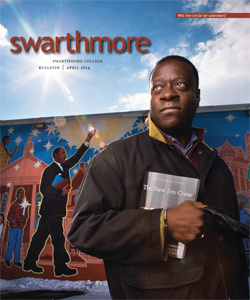Campus Traditions Revisited
Alumni write on about campus cuisine, curfews, and more
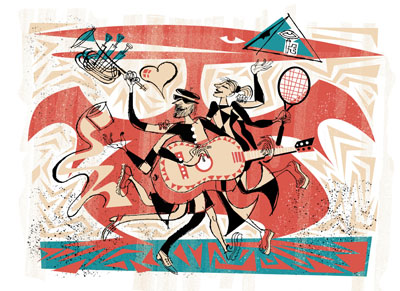
Illustrations by Rowan Barnes-Murphy
In the January Bulletin, we chronicled several student activities that were prominent on campus way back when. Some still exist today. We asked readers to add to the lore. Here are their memories.
Your wonderful article, “Campus Traditions,” brought back several memories. First, regarding Folk Festivals: I attended Swarthmore from fall 1954 through spring 1958. At that time, the Red Scare and Joe McCarthy were in full bloom, and Swarthmore—known affectionately by some of us as “that pinko-commie-symp [sympathizer] college”—was one of the few educational institutions where people like Pete Seeger and Paul Robeson could perform. I remember being entranced by Robeson’s incredible voice as he sang “Old Man River” from the Clothier stage once (not at the Folk Festival). Pete was not just an act at the festival. I can remember being one of a crowd of students, guitar in hand, sitting out on the lawn, having a sing-along with Pete.
Second, about on-campus cuisine: In my day, there was no need to order hoagies in advance. Jesse Aweida ’56 set up a hoagie business. He would stroll through the dorms at night, and there was no mistaking his slight Palestinian accent, as we could hear his mellifluous voice resounding through the halls of Wharton, “Get your hoagies tonight! I have ham and regular hoagies tonight!” I suspect this venture helped pay his way through Swarthmore. Not surprisingly, Jesse went on to become a very successful venture capitalist, helping start many businesses as the managing partner of Aweida Venture Partners.
—Bob Freedman ’58
Concerning the subject of curfews, when I was a student in the late ’40s, the rules were very liberal. (Unfortunately they didn’t change with the times and became very conservative later on.) We could stay out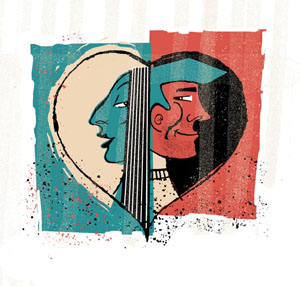 until 10:15 p.m., and, if one signed out, until 12:30 a.m. One time I and about three others had not signedout and missed the 10:15 deadline, so we just stayed out all night, slept in the car, and returned about 7 a.m. As far as I know, no one other than my roommate knew about that escapade. Another rule that was liberalized in 1947 was about students getting married. The rule had been that if two students got married, one of them had to refrain from returning to Swarthmore. In deference to the returning vets, it was changed so that both students could return. I was one of those who took advantage of that. Richard Cordray and I were married June 21, 1947, and both of us were able to return in fall 1947. However, three conditions had to be met: One member of the couple had to be at least 22 years old, both sets of parents had to write letters of approval, and the College president (then John Nason) had to give his approval after interviewing the couple. We passed, and both of us graduated from Swarthmore.
until 10:15 p.m., and, if one signed out, until 12:30 a.m. One time I and about three others had not signedout and missed the 10:15 deadline, so we just stayed out all night, slept in the car, and returned about 7 a.m. As far as I know, no one other than my roommate knew about that escapade. Another rule that was liberalized in 1947 was about students getting married. The rule had been that if two students got married, one of them had to refrain from returning to Swarthmore. In deference to the returning vets, it was changed so that both students could return. I was one of those who took advantage of that. Richard Cordray and I were married June 21, 1947, and both of us were able to return in fall 1947. However, three conditions had to be met: One member of the couple had to be at least 22 years old, both sets of parents had to write letters of approval, and the College president (then John Nason) had to give his approval after interviewing the couple. We passed, and both of us graduated from Swarthmore.
—Arden Fish Cordray Pierce ’49
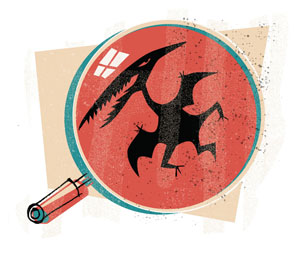
I enjoyed the January 2014 historical issue and especially the subterranean way that folk dancing kept popping up—in the section on the Folk Festival and the section on the Pterodactyl Hunt.
It struck me as odd that in both places, names were omitted that could have been named. First, author Carrie Compton wrote, “Swarthmore students’ love for music found its official footing in 1940 when a women’s physical education teacher organized a barn dance on campus. The wild popularity of the event gave way to weekly instructional classes …” The women’s phys ed teacher has to be Irene Moll. She was still at Swarthmore when I arrived as a freshman (1975), and in orientation week she organized a folk and square dance that introduced many of us to this club. I was one of the many students who started folk dancing because it would help me fulfill my gym requirement. Little did I know that 13 years later, I would meet my future wife through folk dancing! But that’s another story. I just want Irene Moll to get her credit.
Second, to correct some information printed about the Pterodactyl Hunt, I recollect that the idea was hatched by James LaTourette ’81, who was obsessed with pterodactyls. The first hunt was held no later than fall 1979, rather than in 1982, as stated in the article. I don’t think there was any formal publicity, as it wasjust a joke among some of his friends, but I do think that there was an actual model of a pterodactyl involved. It’s possible that the hunt even dates back to fall 1978. It was amazing to learn that a campuswide tradition of 30 years’ standing (and still going) started from one student’s obsession with pterodactyls! My guess is that there were Pterodactyl Hunts in 1979 and 1980. What is definitely true is that James is the patron saint and inventor of the Pterodactyl Hunt and deserves to be duly remembered!
—Dana Mackenzie ’79
Your short piece on Book and Key in the January 2014 Bulletin brought back memories. I was in the last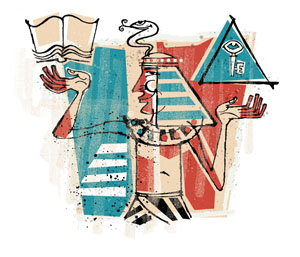 “class” of Book and Key. We were inducted at the end of our junior year (1956) and were active throughout our senior year. My recollection is somewhat different from what you were told. There was no “waning interest” in Bookand Key among the student body in the post-World War II years. The very limited membership invitations were eagerly sought until the end in 1957. As I recall, when we got down to selecting the class to succeed us in 1957, one class member raised an objection to our “exclusive” reputation and said he would not agree to any of the candidates who were put forward. Since we made these selections by consensus, we issued no invitations to new members in spring 1957, and the society became de facto inactive.
“class” of Book and Key. We were inducted at the end of our junior year (1956) and were active throughout our senior year. My recollection is somewhat different from what you were told. There was no “waning interest” in Bookand Key among the student body in the post-World War II years. The very limited membership invitations were eagerly sought until the end in 1957. As I recall, when we got down to selecting the class to succeed us in 1957, one class member raised an objection to our “exclusive” reputation and said he would not agree to any of the candidates who were put forward. Since we made these selections by consensus, we issued no invitations to new members in spring 1957, and the society became de facto inactive.
—Samuel Hayes ’57
 Email This Page
Email This Page